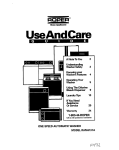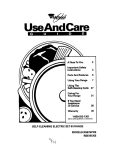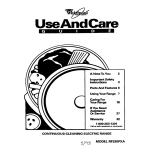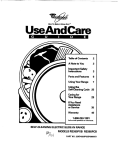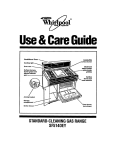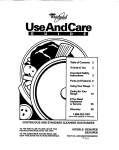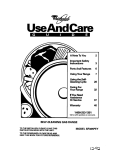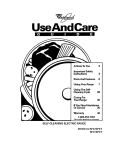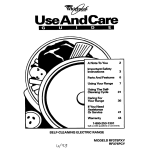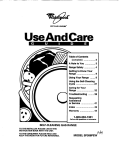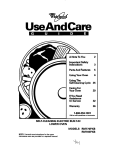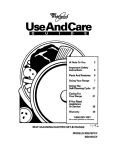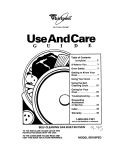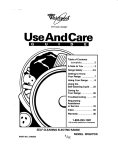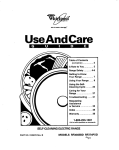Download Whirlpool RF385PXY5 User's Manual
Transcript
-.whI 01’ H HowwdAla*l#llu~- UseAndCare A Note to You 2 Important Safety lnstnrctions 3 Parts and Features 6 Using Your Range 7 Usin the Setf- t! leaning Cycle 30 Caring for Your Range 35 If You Need Assistance or Service 40 Warranty 44 1-800-253-I 301 Call us with questions SELF-CLEANING or comments. ELECTRIC RANGE MODEL RF385PXY5 rolscr A Note to You Thank you for buying a Whirlpool@ appliance. Because your life is getting busier and more complicated, Whirlpool ranges are easy to use, save time, and help you manage your home better. To ensure that you will enjoy years of trouble-free operation, we developed this Use and Care Guide. It is full of valuable information on how to operate and maintain your appliance properly and safely. Please read it carefully. Also, please complete and mail the Ownership Registration Card provided with your appliance. This will help us notify you about any new information on your appliance. Your safety is important to us. This guide contains safety symbols and statements. Please pay special attention to these symbols and follow any instructions given. Here is a brief explanation of the use of each symbol. This symbol will help alert you to such dangers as personal injury, burns, fire, and electrical shock. Our Consumer Assistance Center is toll-free, 24 hours a day. This symbol will help you avoid actions which could cause product damage (scratches, dents, etc.) and damage to your personal property. number, l-800-253-1 301, If you ever have a question concerning your appliance’s operation, or if you need service, first see “If You Need Assistance or Service” on page 40. If you need further help, feel free to call our Consumer Assistance Center. When calling, you will need to know your appliance’s complete model number and serial number. You can find this information on the model and serial number plate (see diagram on page 6). For your convenience, we have included a handy place below for you to record these numbers, the purchase date from the sales slip, and your dealer’s name and telephone number. Keep this book and the sales slip together in a safe place for future reference. Model Number Dealer Name Serial Number Dealer Phone Purchase Date Important Safety Instructions To reduce the risk of fire, electrical shock, injury to persons, or damage when using the range, follow basic precautions, including the following: General l l Read all instructions before using the range. Install or locate the range only in accordance with the provided Installation Instructions. The range must be installed by a qualified installer. The range must be properly connected to electrical supply and grounded. .@ l l l l l l fffdff l @ WARNING: To reduce the risk of tipping the appliance, the appliante must be secured by a properly installed anti-tip bracket. To check if the bracket is installed properly, see “The anti-tip bracket” on page 29. CAUTION: Do not store things children might want above the range. Children could be burned or injured while climbing on it. Do not leave children alone or unattended in area where the range is in use. They should never be allowed to sit or stand on any part of the range. They could be burned or injured. Do not operate the range if it is damaged or not working properly. Do not use the range for warming or heating the room. Persons could be burned or injured, or a fire could start. Use the range only for its intended use as described in this manual. a Do not touch surface units, areas near units, heating elements, or interior surfaces of oven. Surface units and heating elements may be hot even though they are dark in color. Areas near surface units and interior surfaces of an oven become hot enough to cause burns. During and after use, do not touch or let clothing or other flammable materials contact surface units, areas near units, heating elements, or interior surfaces of oven until the have had sufficient time to coo. r Other surfaces of the range, such as the oven vent opening, the surface near the vent opening, the cooktop, and the oven door and window, could also become hot enough to cause burns. \ l @ Do not wear loose or hanging garments when using the range. They could ignite if they touch a hot surface unit and you could be burned. continued on next page 3 *Use only d pot holders. Moist or damp por holders on hot surfaces could result in burns from steam. Do not let pot holder touch hot heating elements. Do not use a towel or bulky cloth for a pot holder. It could catch on fire. l Keep range vents unobstructed. *Do not heat unopened containers. They could explode. The hot contents could cause burns and container particles could cause Injury. l Do not store flammable materials on or near the range. The fumes could create an explosion and/or fire hazard. When l l l 4 using l Check to be sure lass cooking utensils are sa3e for use on the range. Only certain types of glass, glass-ceramic, ceramic, earthenware, or other glazed utensils are suitable for cooktops without breaking due to the sudden change in temperature. *Never leave surface units unattended at high heat settings. A boilover could result and cause smokin and gr;;iy splllovers t I! at could . the cooktop Make sure the reflector bowls are in place during cooking. Cooking without reflector bowls could subject the wirin and components undernea ?h them to damage. Do not line reflector bowls with aluminum foil or other liners. Improper installation of these liners could result in a risk of electric shock or fire. Select a pan with a flat bottom that is about the same size as the surface unit. If pan is smaller than the surface unit, some of the heating element will be exposed and could result in the igniting of clothing or pot holders. Correct pan size also improves cooking efficiency. @Turn pan handles inward, but not over other surface units. This will help reduce the chance of burns, i niting of flammable materia 9 s, and spills due to bumping of the pan. When using the oven @Always position oven rack(s) in desired location while oven is cool. If a rack must be removed while oven is hot, do not let pot holder contact hot heating element in oven. @Use care when opening oven door. Let hot air or steam escape before removing or replacing food. Grease l Grease is flammable. Do not allow grease to collect around cooktop or in vents. Wipe spillovers immediately. @Do not use water on grease fires. Never pick up a flaming pan. Smother flaming pan on range by coverin with a wellfitted lid, cookie s7l eet, or flat tray. Flaming grease outside of an can be extin uished with Ii aking soda or, i9 available, a multipurpose dry chemical or foam-type extinguisher. Care and cleaning *Small amounts of formaldehyde and carbon monoxide are iven off in the Self-Cleaning cyc9e from fiberglass insulation and food decomposition. Si nificant exposure to these subs 4antes could cause cancer or reproductive harm. Exposure can be minimized by venting with a hood or open window and wiping out excess food spills prior to self-cleaning. *Do not use oven cleaners. No commercial oven cleaner or oven liner rotective coating of any kind s c:ould be used in or around any part of the oven. *Before self-cleaning the oven, remove broiler pan, broiler gnd, oven racks, and other utensils. Do not use your oven to clean miscellaneous parts unless you are instructed to do so in this Use and Care Guide. @Do not soak removable heating elements in water. The element will be damaged and shock or fire could result. @Do not clean door heat seal. It is essential for a ood seal. Care should be ta% en not to rub, damage, or move the seal. Clean only parts recommended in this Use and Care Guide. l Do not repair or replace any part of the range unless specifitally recommended in this manual. All other servicing should be referred to a qualified technician. aDisconnect the electrical supply before servicing the range. - SAVE THESE INSTRUCTIONS - 5 Parts and Features This section contains captioned illustrations of your range. Use them to become familiar the location and appearance of all parts and features. H Plug-in surface unit with Dorcelain-enamel deflector bowl(Model RF385PXY, Q series, includes chrome trim ring) with Oven vent Automatk oven light switch element element Anti-tip floor bracket y (for information on optional wallmounted anti-tip bracket kii, see page 29) Removable storage drawer’ Control _ panel Left front control knob Surface 6 Left rear control knob I unit marker Electronic oven control Right rear control knob Surface Manual oven light switch I unit indicator Fiig; control knob light Using Your Range In This Section Page Using the surface units.. ................... .7 Positioning racks and pans.. ............ .8 For best air circulation .................... .I0 Using aluminum foil for baking.. .... .I0 The electronic oven control.. .......... .ll Setting the clock ............................... 12 Using the electronic Minute Timer ..I 2 Using the Off/Cancel pad ................ .13 Audible signals ................................. 13 Baking/roasting ................................ 14 Page the oven temperature .... ....... ......... ........................... 15 Broiling .............................................. 16 Broiling tips ....................................... 17 Energy saving tips ............................ 18 Using the electronic MEALTIMER’” control ............................................... 18 The oven vent ................................... 28 The storage drawer .......................... 28 The anti-tip bracket .......................... 29 Optional door panel pat ................. .28 Ad$;J;ng To obtain the best cooking results possible, you must operate your range properly. This section gives you important information for efficient and safe use of your range. Using the surface units Push in control knobs before turning them to a setting. You can set them anywhere between HI and OFF. Surface unit markers The solid dot in the surface unit marker shows which surface unit is turned on by that knob. Surface unit indicator lights One of the Surface Unit Indicator Lights on the control panel will glow when a surface unit is on. Fire Hazard Be sure all control knobs are turned to OFF and all indicator lights are OFF when you are not cooking. Someone could be burned or a fire could start if a surface unit is accidentally left ON. 7 Until you get used to the settings, use the following as a guide. For best results, l start cooking at the high setting; then turn the control knob down to continue cooking. SElTlNG HI Cookware tips Select a pan that is about the same size as the surface unit. l NOTE: For best results and greater energy efficiency, use only flat-bottomed l l l cookware that makes good contact with the surface units. Cookware with rounded, warped, ribbed (such as some porcelain enamelware), or dented bottoms could cause severe overheating, which damages the cookware and/or surface unit. You can, however, use the newer cookware available with slightly indented bottoms or very small expansion channels. This cookware is specially designed to provide the good contact needed for best cooking results. Also, woks, canners, and teakettles with flat bottoms suitable for use on your cooktop are now available in most stores that sell housewares. The pan should have straight sides and a tight-fitting lid. Choose medium to heavy gauge (thickness) pans that are fairly lightweight. 8 unit through the pan material and how evenly heat spreads over the pan bottom. Choose pans that provide the best cooking results. RECOMMENDED USE . To start foods cooking. l To bring liquids to a boil. Medium-high . To hold a rapid boil. . To fry chicken or pancakes. l For gravy, pudding, and Medium icing. (opposite OFF) l To cook large amounts of vegetables. Medium-low l To keep food cooking after starting it on a hiaher settina. l To keep food warm until LO ready to serve. The pan material (metal or glass) affects how fast heat transfers from the surface l Handles should be made of sturdy, heatresistant material and be securefy attached to the pan. NOTES: l l If a surface unit stays red for a long time, the bottom of the pan is not flat enough or is too small for the surface unit. Prolonged usage of incorrect utensils could result in damage to the surface unit, cooktop, wiring, and surrounding areas. To prevent damage, use correct utensils, start cooking on HI, and turn control down to continue cooking. Do not leave an empty utensil, or one which has boiled dry, on a hot surface unit. The utensil could overheat and could damage the utensil or surface unit. Home canning information Optional canning kit To protect your range: l Use flat-bottomed canners/pans for best results. l l l l l l Use the largest surface unit for best results. Also, use a canner/pan which can be centered over the surface unit and which does not extend more than one inch outside surface unit area. Large diameter canners/pans, if not properly centered, trap heat and can cause damage to the cooktop. Do not place canner on two surface units at the same time. Too much heat will build up and will damage the cooktop. Start with hot water. This reduces the timethe control is set on high. Reduce heat setting to lowest position needed to keep water boiling. Keep reflector bowls clean for best heat reflection. To prolong the life of the elements: - Prepare small batches at a time. - Do not use elements for canning all day. Refer to your canner manual for specific instructions. Positioning For baking/roasting racks The large diameter of most water-bath or pressure canners combined with high heat settings for long periods of time can shorten the life of regular surface units and cause damage to the cooktop. If you plan to use the cooktop for canning, we recommend the installation of a Canning Kit. Order the kii (Part No. 242905) from your Whirlpool dealer or authorized Whirlpool service company. and pans with one rack, place the rack so the top of the food will be centered in the oven. Rack placement for specific foods: j RACK POSITION 1 FOOD Lowest level or Frozen pies, large roasts, turkeys, angel I 2nd level from foodcakes 1 bottom 2nd level from Bundt cakes, most bottom quick breads, yeast breads, casseroles, meats 2nd or 3rd level Cookies, biscuits, from bottom muff ins, cakes, nonfrozen pies When baking on two racks, arrange racks on bottom and third level from bottom. NOTE: For recommended rack placement when broiling, see “Broiling rack position chart” on page 17. Personal Injury Hazard 9 Always position oven rack(s) in desired location before turning oven on. Be sure the rack(s) is level. l If rack(s) must be moved while oven is hot, use pot holders or oven mitts to protect hands. Failure to follow the above precautions could result in personal injury. For best air circulation Hot air must circulate around the pans in the oven for even heat to reach all parts of the oven. This results in better baking. l Place the pans so that one is not directly over the other. l For best results, allow 1 l/2 to 2 inches (4-5 cm) of space around each pan and between pans and oven walls. There must be a minimum space of 1 inch (2.5 cm). l Use only one cookie sheet in the oven at one time. Use the following as a guide to determine where to place the pans: One pan Place in the center of the oven rack. Two pans Place in opposite corners of the oven rack. Three or four pans Place in opposite corners on each oven rack. Stagger pans so no pan is directly over another. Using aluminum foil for baking Use aluminum foil to catch spillovers pies or casseroles: l Place the foil on the oven rack below with the food. Turn up foil edges and sure foil is about 1 inch (3 cm) larger l l from the rack make all around than the dish holding the food. Do not cover the entire rack with aluminum foil. It will reduce air circulation and cause poor cooking results. Do not line oven bottom or entire oven rack with foil or other liners. Poor baking will result. Electrical Shock and Fire Hazard Do not allow foil to touch the heating elements. Failure to follow this precaution could result in electrical shock or fire hazard and damage to the elements. 10 1 The electronic oven control Timer set and off pads Clock pad Electronic display Oven seettor Temperature pads Electronic MEALTIMER control pads Display/clock When you first plug in the range, every- l l l l l l thing on the display will light up for l-2 seconds, then a time of day and “PF’ will appear on the temperature display. If, after you set the clock (page 12) “PF again appears on the display, your electricity was off for a while. Reset the clock. When you are not using the oven, the control is an accurate clock. When you are using the oven or Minute Timer, the display will show times, temperature settings, and what command pads have been pressed. When showing the time of day, the display will show the hour and minutes. When you are using the Minute Timer, Hour Minute pads pads Start/ enter pad Off/ cancel pad Each command pad (except Off/Cancel and Start/Enter) has its own Indicator Light. The Indicator Light comes on when you push the command pad. Using the control lock The control lock prevents unwanted use of the oven by disabling the control panel command pads. NOTES: l Control lock is only available when oven l is not in use or control has not been set. Set control lock when cleaning the control panel to prevent oven from accidentally turning on. To lock or deactivate the control panel: the display will show minutes and seconds in the following sequence: - For settings from l-59 minutes, the display will count down each second. - For settings 1 hour or over, the display will count down each minute. Push and hold the Start/Enter pad for 5 seconds. A single tone will sound and “Lot” and fi will appear on the temperature display. When the control is locked, “START?” will appear on the display and three tones will sound if you push any command pad. When you are using Cook Time and/or To unlock the control panel: Stop Time, the display will show hours and minutes. Command pads The command pads tell the oven what to do and in what order. A few examples: -Clock tells the oven you are going to set the clock. -Off/Cancel tells the oven to turn off. Push and hold the Start/Enter pad for 5 seconds. A single tone will sound and “Lot” and fi will disappear from the temperature display. 11 Setting the clock 0 1. Push the Clock pad. The colon flashes and TIME will light up on the display. CLOCK 2. Use the Hour and Minute pads to set the time of day. Push the “up” (A) or “down” (i) pad(s) until the correct time shows on the display. 3. Push the Start/Enter pad. NOTE: If you do not want the clock time displayed, push and hold the Clock pad for 5 seconds. To display the clock time again, push and hold the Clock pad for 5 seconds. You should not have to reset the time. Using the electronic The Minute Timer does not start or stop the oven. It works like a kitchen timer. It can be set in hours and minutes up to 12 hours, 59 minutes. The Minute Timer will display minutes and seconds for settings under one hour. You will hear four l-second tones when the set time is up. 1. Push the Timer Set pad. TIMER will come on and the display will show “:OO” with the colon flashing. 2. Use the Hour and Minute pads to set the desired time. Push the “up” (A) or “down” (V) pad(s) until the correct time shows on the display. 12 Minute Timer f-l TIMER SET 3. Push the Start/Enter pad. The Minute Timer will begin counting down immediately after the timer is started. When time is up, “End” will show on the large display and you will hear four P-second tones. You will also hear four 1-second tones every minute until you push one of the two Timer pads. NOTE: To disable the reminder tones, push and hold the Timer Set pad for 5 seconds. To reactivate the tones, follow the same procedure. To cancel l the Minute Timer: Push the Timer Off pad. The time of day will show on the display. Using the Off/Cancel pad The Off/Cancel pad will cancel any function except for the Clock and Timer Set functions. When you push the Off/Cancel pad, the display will show the time of day or, if Minute Timer is also being used, the time remaining. Audible signals Audible signals tell you if a function is entered correctly or not. They also tell you when a cycle is completed. To shut off all signals except for the end-of-timer and error tones: Push and hold the Stop Time pad for 5 seconds. A short tone will sound to tell you the signals have been changed. Repeat the above step to turn the signals back on. To choose between high and low volume signals: Push and hold the Delay Start Time pad for 5 seconds. A short tone will sound to tell you the signals have been changed. Either “HI” or “LO” will appear on the time display to show the volume you chose. 13 Baking/roasting 1. Position the rack(s) properly before turning on the oven. To change rack position, lift rack at front and pull out For further information, see “Positioning racks and pans” on page 9. 2. Push the Bake pad. “350°F will light up on the small display to show the preset temperature and BAKE will light up. 3. To cook at a different temperature, use the Temp pad(s). Push A to raise the temperature or V to lower the temperature in 5°F increments. Use these pads until the desired temperature shows on the small display. 4. When roasting or cooking casseroles, put food in the oven. 5. Push the Start/Enter pad. “PrE”, HEAT, BAKE, and ON will light up. A preheat time will count down on the display. The oven control automatically sets preheat times depending on the oven temperature you select: . For 320°F and less, the preheating time is 6 minutes. l For 325”F-375”F, the preheating time is 6 minutes. l For above 38O”F, the preheating time is 10 minutes. 6. The oven is preheated when you hear a 1-second tone and “PrE” on the display changes to the set temperature. NOTES: @YOUcan change the temperature setting any time after pushing the Start/Enter pad. However, you must push the Start/Enter pad again. *The display will show “door” and a tone will sound once every 5 seconds if the door is , 4 latched when you try to bake/roast. (example for set temperature of 350°F) 7. When baking, put food in the oven. During baking/roasting, the elements will turn on and off to keep the oven temperature at the setting. NOTE: The top element helps heat during baking/roasting, but does not turn red. 8. When baking/roasting is done, push the Off/Cancel pad. The time of day will show on the display and all other displays will go off. Adjusting the oven temperature control Although your new oven is properly adjusted to provide accurate temperatures, it may cook faster or slower than your old oven. If, after using the oven for a period of time, you are not satisfied with the baking/roasting results, you can change the temperature calibration by following these steps: 1. Push the Bake pad and hold for 5 seconds. The display will show the current offset temperature, for example “O”, if you have not previously adjusted the temperature. 2. To adjust the temperature, use the Temp pad(s). Push A to raise the temperature or V to lower the temperature in 10°F increments. You can set the temperature change to as low as -30°F or as high as +3O”F. A minus (-) sign will appear before the number when decreasing the temperature setting to show the oven will be cooler by the displayed amount. There is no sign in front of the number when increasing the temperature setting. 3. After making the desired adjustment, push the Start/Enter pad to enter the new offs-et temperature. To display temperatures instead of OF: in “C Push and hold the Broil pad for 5 seconds. A short tone will sound and the temperatures displayed will be converted. To switch back to “F, repeat the instructions above. 1 llll :-. m 15 Broiling NOTE: Preheating is not necessary when broiling. 1. Position the rack before turning the oven on. See “Broiling rack position chart” on page 17. 2. Put the broiler pan and food on the rack. 3. Close the door to the Broil Stop position (open about 4 inches [lo cm]). The door will stay open by itself. 4. Push the Broil pad. The small display will show “500°F and BROIL will light up. 5. Push the Start/Enter pad. HEAT, BROIL, ON, and “500°F will show on the display. NOTE: You can change the temperature setting any time after pushing the Start/Enter pad. To change the setting, see “To custom broil at a lower temperature” below. After changing the setting, you must push the Start/ Enter pad again. 6. When broiling is done, push the CM/Cancel pad. The time of day will show on the display and all other displays will go off. . lllll To custom temperature: l l broil at a lower If food is cooking too fast, push the Broil pad and push the V Temp pad until “325°F shows on the small display. Push the Start/Enter pad. If you want to broil slower from the start, push the Broil pad and push the V Temp pad so a temperature between 170°F and 325°F (77°C and 163°C) shows on the small display. Push the Start/Enter pad. These temperature settings allow the broil heating element to cycle and to slow cooking. The lower the temperature, the slower the cooking. BROIL, ON, and HEAT will light up on the display. 16 . :-. m!!! (example shows Broil at 325°F) NOTES: Fish and chicken are some foods that l may cook better if you use lower broiling temperatures. Leave the door partly open whenever using the oven to broil. This allows the oven to maintain proper temperatures. l Broiling rack position chart TYPE OF FOOD/ DONENESS RACK POSITION Hamburger patties and thin steaks %” thick or less ’ c 3 Quickly searing food, rare and medium steaks, medium patties ham slices, fish steaks, frankfurters 2 Well-done steaks and patties, lamb chops, split chicken, pork steaks and chops, whole fish 1 Not used for broiling Broiling l l tips Use the broiler pan and grid for broiling. They, are designed to drain excess liquid and grease away from the cooking surface to help prevent spatter, smoke, or fire. After broiling, remove the broiler pan from the oven when you remove the food. Drippings will bake on the pan if you leave it in the heated oven. I Fire Hazard Place meat the correct distance from the element. Meat placed too close to the element could spatter, smoke, burn, or catch fire during broiling. *To ensure adequate grease drainage, do not use cookie sheets or similar pans for broiling. Also, covering the broiler grid with foil is not recommended. If foil is used, cut slits in foil to line up with all openings in broiler grid. Grease can then drain away and cool in pan. Poor drainage of grease could result in fire. l 17 Energy saving tips Although the energy used for cooking is usually a very small percentage of the total energy used in the home, cooking energy can be used efficiently. Here are some tips to help you save energy when using your cooking product: l Us6 pans with flat bottoms, straight sides, and tight-fifing lids. unft size. l Match the pan to the surface l Cook with a minimum of liquid or fat to help shorten cooking time. l Preheat pans only when recommended and for the shortest time possible. l Start food on higher heat settings, then set surface unit control on low or off to finish cooking. Use retained heat for cooking when possible. l l l l l l l Using the electronic Use the more efficient surface units instead of the oven when possible. Turn on the surface unit only after placing filled pan on the unit. “Oven peeking” may cause heat loss, longer cooking times, and unsatisfactory baking results. Rely on your timer to keep track of the cooking time. Bake cakes, pies, or cookies when oven is warm. Best time to bake is right after a meal has been cooked in oven. Preheat the oven no longer than necesSW. Plan your meals for the most effiiient use of the range. When using the oven to cook one food, try to cook the rest of the meal in it also. Do not preheat when broiling, roasting, or cooking items such as casseroles. MEALTIMER” Before using the electronic MEALTIMER control, make sure the clock is set to the correct time of day. (See “Setting the The electronic MEALTIMERTM control will turn the oven on and off at times you set, even when you are not around. Delayed time baking/roasting is ideal for foods which do not require a preheated oven, such as meats and casseroles. Do clock” on page 12.) not Use delayed time cooking for cakes, cookies, etc. - undercooking will result. This section discusses two methods for starting baking/roasting now and stopping automatically later, and three methods for starting and stopping baking/roasting automatically. Read this section carefully to choose which method(s) is best for you. To start baking/roasting Method l-Using Cook now Time: 1. Position the oven rack(s) properly and put food in the oven. 18 control and stop automatically 2. Push the Bake pad to enter the Bake mode (BAKE will light up). Use the Temp pad(s) to set the desired temperature. Push A to raise the temperature or V to lower the temperature in 5°F increments. Use these pads until the desired temperature shows on the small display. After you have set the desired temperature, the display will show the set temperature and the time of day. 3. Push the Cook Time pad. “:OO” with the colon flashing and COOK TIME will show on the display. 4. Use the Hour and Minute pads to set the desired cooking time. Push the “up” (A) or “down” (V) pad(s) until the correct time shows on the display. This example shows a desired baking/ roasting time of 30 minutes. 5. Push the Start/Enter pad. HEAT, BAKE, TIMED, ON, COOK TIME, and the set cook time and temperature will light up on the display to show that the oven is heating. NOTES: You can change the temperature or l time settings any time after pushing the Start/Enter pad by repeating just Steps 2 through 4. l The display will show “door” and a tone will sound once every 5 seconds if the door is latched when you try to bake/roast. 6. The display will count down the baking/ roasting time in hours and minutes (if cook time is more than one hour) or in minutes and seconds (if cook time is less than one hour). 19 7. When the baking/roasting time is completed, the oven will turn off automatically, beep four times, and “End” will show on the display. You will also hear four 1 -second tones every minute until you push the Off/Cancel pad. NOTE: To disable reminder tones, push and hold the Cook Time pad for 5 seconds. To reactivate tones, repeat this procedure. To cancel the MEALTIMER”’ control setting: l Push the Off/Cancel pad to return the display to the time of day. Method Z-Using Stop Time: 1. Position the oven rack(s) properly and put food in the oven. 2. Push the Bake pad to enter the Bake mode (BAKE will light up). Use the Temp pad(s) to set the desired temperature. Push A to raise the temperature or V to lower the temperature in 5°F increments. Use these pads until the desired temperature shows on the small display. After you have set the desired temperature, the display will show the set temperature and the time of day. 3. Push the Stop Time pad. The time of day with the colon flashing and STOP TIME will show on the display. 4. Use the Hour and Minute pads to set the desired stop time. Push the “up” (A) or “down” (V) pad(s) until the correct time shows on the display. This example shows a desired stop time of 2 o’clock. This provides a 2-hour cook time (the difference between the time of day and the stop time). 20 5. Push the Start/Enter pad. The set temperature, HEAT, BAKE, TIMED, and ON will light up on the display to show that the~oven is heating. NOTES: You can change the temperature or l time settings any time after pushing the Start/Enter pad by repeating just Steps 2 through 4. l The display will show “door” and a tone will sound once every 5 seconds if the door is latched when you try to bake/roast. 6. The display will count down the baking/ roasting time in hours and minutes (if cook time is more than one hour) or in minutes and seconds (if cook time is less than one hour). 7. When the baking/roasting time is completed, the oven will turn off automatically, beep four times, and “End” will show on the display. You will also hear four 1-second tones every minute until you push the Off/ Cancel pad. NOTE: To disable reminder tones, push and hold the Cook Time pad for 5 seconds. To reactivate tones, repeat this procedure. To cancel the MEALTIMER” control setting: l Push the Off/Cancel pad to return the display to the time of day. To delay start automatically and stop Method l-Using Cook Delay Start Time: Time and 1. Position the oven rack(s) properly and put food in the oven. 2. Push the Bake pad to enter the Bake mode (BAKE will light up). Use the Temp pad(s) to set the desired temperature. Push A to raise the temperature or V to lower the temperature in 5°F increments. Use these pads until the desired temperature shows on the small display. After you have set the desired temperature, the display will show the set temperature and the time of day. 3. Push the Cook Time pad. “:OO” with the colon flashing and COOK TIME will show on the display. 4. Use the Hour and Minute pads to set the desired cooking time. Push the “up” (A) or “down” (V) pad(s) until the correct time shows on the display. cl COOK TIME This example shows a desired baking/ roasting time of 30 minutes. 5. Push the Delay Start Time pad. The time of day with the colon flashing will show on the display and START TIME will light up. rl DELAY stiE 6. Use the Hour and Minute pads to set the desired start time. Push the “up” (A) or “down” (V) pad(s) until the correct time shows on the display. This example shows a desired start time of 2 o’clock. The oven will automatically shut off at 2:30 (the set start time plus the set cook time). 7. Push the Start/Enter pad. DELAY, BAKE, and ON will light up on the display to show that the oven is set to start at a later time. NOTES: You can change the temperature or l l 22 time settings any time after pushing the Start/Enter pad by repeating just Steps 2 through 6. The display will show “door” and a tone will sound once every 5 seconds if the door is latched when you try to bake/roast. .llli- 8. When the start time is reached, a l-second tone will sound and DELAY will go off. The display will show the set cook time. The set temperature, HEAT, TIMED, BAKE, and ON will light up on the display to show that the oven is heating. The display will count down the baking/roasting time in hours and minutes (if cook time is more than one hour) or in minutes and seconds (if cook time is less than one hour). 9. When the baking/roasting time is completed, the oven will turn off automatically, beep four times, and “End” will show on the display. You will also hear four 1 -second tones every minute until you push the Off/Cancel pad. NOTE: To disable reminder tones, push and hold the Cook Time pad for 5 seconds. To reactivate tones, repeat this procedure. To cancel the MEALTIMER” control setting: l Push the Off/Cancel pad to return the display to the time of day. Method 2-Using Delay Time and Stop Time: Start 1. Position the oven rack(s) properly and put food in the oven. 2. Push the Bake pad to enter the Bake mode (BAKE will light up). Use the Temp pad(s) to set the desired temperature. Push A to raise the temperature or V to lower the temperature in 5°F increments. Use these pads until the desired temperature shows on the small display. After you have set the desired temperature, the display will show the set temperature and the time of day. 3. Push the Delay Start Time pad. The time of day with the colon flashing will show on the display and START TIME will light up. rl DELAY START TIME 23 4. Use the Hour and Minute pads to set the desired start time. Push the “up” (A) or “down” (V) pad(s) until the correct time shows on the display. This example shows a desired start time of 2 o’clock. 5. Push the Stop Time pad. The time of day with the colon flashing will show on the display and STOP TIME will light up. 6. Use the Hour and Minute pads to set the desired stop time. Push the “up” (A) or “down” (V) pad(s) until the correct time shows on the display. This example shows a desired stop time of 2:30. This provides a cook time of 30 minutes (the difference between the start and stop times). NOTE: If you do not set a stop time, the colon will flash on the display and STOP and COOK will flash alternately to remind you to program a stop time or a cook time. (See page 21 for instructions on how to set delay start and stop automatically using Cook Time and Delay Start Time.) 7. Push the Start/Enter pad. DELAY, BAKE, and ON will light up on the display to show that the oven is set to start at a later time. NOTES: You can change the temperature or l l 24 time settings any time after pushing the Start/Enter pad by repeating just Steps 2 through 6. The display will show “door” and a tone will sound once every 5 seconds if the door is latched when you try to ba kc/roast . 8. When the start time is reached, a 1-second tone will sound and DELAY will go off. The display will show the set cook time. The set temperature, HEAT, TIMED, BAKE, and ON will light up on the display to show that the oven is heating. The display will count down the baking/roasting time in hours and minutes (if cook time is more than one hour) or in minutes and seconds (ii cook time is less than one hour). 9. When the baking/roasting time is completed, the oven will turn off automatically, beep four times, and “End” will show on the display. You will also hear four 1 -second tones every minute until you push the Off/Cancel pad. NOTE: To disable reminder tones, push and hold the Cook Time pad for 5 seconds. To reactivate tones, repeat this procedure. To cancel the MEALTIMER” control setting: l Push the Off/Cancel pad to return the display to the time of day. Method 3-Using and Stop Time: Cook Time 1. Position the oven rack(s) properly and put food in the oven. 2. Push the Bake pad to enter the Bake mode (BAKE will light up). Use the Temp pad(s) to set the desired temperature. Push A to raise the temperature or V to lower the temperature in 5°F increments. Use these pads until the desired temperature shows on the small display. After you have set the desired temperature, the display will show the set temperature and the time of day. 3. Push the Cook Time pad. “:OO” with the colon flashing and COOK TIME will show on the display. 25 4. Use the Hour and Minute pads to set the desired cooking time. Push the “up” (A) or “down” (V) pad(s) until the correct time shows on the display. This example shows a desired baking/ roasting time of 30 minutes. 5. Push the Stop Time pad. The time of day with the colon flashing will show on the display and STOP TIME will light up. 6. Use the Hour and Minute pads to set the desired stop time. Push the “up” (A) or “down” (V) pad(s) until the correct time shows on the display. This example shows a desired stop time of 2:30. The oven will automatically start cooking at 2:00 (the set stop time minus the set cook time). 7. Push the Star&/Enter pad. DELAY, BAKE, and ON will light up on the display to show that the oven is set to start at a later time. NOTES: You can change the temperature or l l 26 time settings any time after pushing the Start/Enter pad by repeating just Steps 2 through 6. The display will show “door” and a tone will sound once every 5 seconds if the door is latched when you try to bake/ roast. A A HR MIN v v I I 8. When the start time is reached, a l-second tone will sound and DELAY will go off. The display will show the set cook time. The set temperature, HEAT, TIMED, BAKE, and ON will light up on the display to show that the oven is heating. The display will count down the baking/roasting time in hours and minutes (if cook time is more than one hour) or in minutes and seconds (if cook time is less than one hour). 9. Wh&n the baking/roasting time is completed, the oven will turn off automatically, beep four times, and “End” will show on the display. You will also hear four 1 -second tones every minute until you push the Off/Cancel pad. NOTE: To disable reminder tones, push and hold the Cook Time pad for 5 seconds. To reactivate tones, repeat this procedure. To cancel the MEALTIMER” control setting: l Push the Off/Cancel pad to return the display to the time of day. To avoid sickness and food waste when using the MEALTIMERm control: l l Do not let most UNFROZEN food stand for more than two hours before cooking starts. Do not allow food to remain in oven for more than two hours after the end of cooking cycle. NOTE: Do not use foods that will spoil while waiting for cooking to start. Such foods are: dishes with milk or eggs, cream soups, and cooked meats or fish. Also, foods containing baking powder or yeast will not rise properly when cooked using delay start. 27 The oven vent Hot air and moisture escape from the oven through a vent under the right rear surface unit. You can cook on the unit or keep food warm on it while the oven is on. The vent is needed for air circulation. Do not block the vent. Poor baking/roasting can result. NOTE: Plastic utensils left over the vent can melt. Fire Hazard l l If you leave a utensil on the right rear surface unit, use pot holders when moving it. Pan handles could become hot enough to burn. Keep flammable materials away from oven vent. Failure to do so could result in burns or a fire. The storage drawer You can remove the storage drawer to make it easier to clean under the range and to check for installation of the anti-tip floor bracket (if you have one). Use care when handling the drawer. Removing the storage drawer: 1. Empty drawer of any pots and pans before removing drawer. Pull drawer straight out to the first stop. Lift front and pull out to the second stop. 2. Lift back slightly and slide drawer all the way out. Replacing the storage drawer: 1. Fit ends of drawer slide rails into the drawer guides on both sides of opening. 2. Lift drawer front and push in until metal stops on drawer slide rails clear white stops on drawer guides. Lift drawer front again to clear second stop and slide drawer closed. 28 . The anti-tip bracket The range will not tip during normal use. However, tipping can occur if you apply too much force or weight to the open door without the anti-tip bracket properly secured. Personal injury Hazard *To reduce risk of range tipping over, secure range with a properfy installed anti-tip bracket supplied with range or an optional wallmounted anti-tip bracket kit. l If range is moved for cleaning or service, check that anti-tip bracket is engaged before using range. Failure to follow the above precautions could result in personal injury. To verify engaged bracket): the anti-tip bracket (if you have a floor is Remove the storage drawer. (See page 28.) l Rear leveling leg Look to see if the anti-tip bracket is attached to floor with screws. Make sure one rear leveling leg is positioned under the anti-tip bracket. See Installation Instructions for further details. l l l To verify engaged bracket): l the anti-tip bracket (if you have a wall is Floor bracket Cable (attached Look to see if the anti-tip bracket is attached with screws to the wall behind the control panel. 9 Make sure the cable on the back of the range is secured by the two hooks on the bracket. l Cable must be unhooked from wall bracket to move range for cleaning or service. Reconnect cable before using range. l Sea Installation Instructions for further details. .-, Optional door panel fcookEl Of panel) Wall bracket pat If you would like to change the color of your oven door glass to white or almond, you can order one of these kits from your Whirlpool Dealer. The kits include easy installation instructions. l White (Kit No. 814069) l Almond (Kit No. 814070) 29 Using the Self-Cleaning Cycle In This Section Page Page How the cycle works ........................ 30 Before you start ............ .................... 30 Setting the controls ............. .. ........... 31 Special tips ...................... ....... ........... 34 The Self-Cleaning cycle saves you from the toil and mess that often come with handcleaning the oven interior. Like the other functions of your range, you operate the SelfCleaning cycle with the easy-to-use electronic control. Please review the instructions in this section to keep your oven spotless. How the cycle works The Self-Cleaning cycle uses very high heat to burn away soil and grease. During the cycle, the oven gets much hotter than it does for normal baking or broiling. This high heat breaks up the soil or grease and burns it away. Your oven is preset for a 3%hour SelfCleaning cycle. However, you can adjust the cycle time to the amount of soil in your oven. You can set the cycle anywhere between 2% and 4% hours. (See “Setting the controls” on page 31.) The graph at the right is representative of a nor-mal, 3%hour Self-Cleaning cycle. Note that the heating stops 1/2hour before the 3&hour setting is up. Before you start Before you start the Self-Cleaning cycle, make sure you: l Hand-clean the areas shown. They do not get hot enough during the cleaning cycle for soil to burn away. Use hot water and detergent or a soapy steel-wool pad for cleaning. NOTE: DO NOT clean, move, or bend the seal. Poor cleaning, baking, and roasting may result. 30 1 I WWF (4M-C) CLEA”lNC CYCLE START 3 1 Tlnm Iti Hours 8ToP l l l l Remove the broiler pan grid and any pots and pans being stored in the oven. NOTE: You can clean the broiler pan (without grid) in the oven if you have first removed most of the soil by handcleaning or in a dishwasher. If most of the soil is not removed, too much smoking will occur. The chrome broiler pan grid will discolor if cleaned in the Self-Cleaning cycle. Wipe out any loose soil or grease. This will help reduce smoke during the SelfCleaning cycle. Personal injury Hazard .Do not touch the oven during Cleaning cycle. It could burn l Do not use commercial oven in your oven. Cleaners could hazardous fumes or damage lain finish. NOTES: Do not force the Lock Lever. You could l Remove the oven racks from the oven if you want them to remain shiny. You can clean the oven racks in the SelfCleaning cycle, but they will become harder to slide. (See page 38.) If you clean racks in the Self-Cleaning cycle, place them on the 2nd and 4th rack guides. (Guides are counted from bottom to top.) Heat and odors are normal during the Self-Cleaning cycle. Keep the kitchen well ventilated by opening a window or by turning on a vent hood or other kitchen vent during the cycle. Setting the Selfyou. cleaners produce the porce- l l l l bend or break it. The lever is designed to stay locked until the oven is cool enough to safely open. Wait until it moves freely. Do not block the vent during the SelfCleaning cycle. Air must move freely for best cleaning results. Do not leave plastic utensils near the vent. They may melt. Do not leave any foil in the oven during the Self-Cleaning cycle. Foil could burn or melt and damage the oven surface. The oven light will not work during the Self-Cleaning cycle. the controls 1. Make sure the clock is set to the correct time of day. (See “Setting the clock’ on page 12.) 2. Move the Lock Lever all the way to the right-the Clean position. 3. Set the cleaning cycle. To start cleaning immediately: Push the Clean pad. A 3%hour SelfCleaning cycle will be set automatically. “3:30” with the colon flashing will show on the large display and “cln” will show on the small display. CLEAN TIME will light up. 31 If a cleaning cycle other than 3% hours is desired, use the Hour and Minute pads to set the desired cleaning time. Push the “up” (A) or “down” (V) pad(s) until a time between 21/2-4’/2hours shows on the display. l Use 2% hours for light soil. l Use 31~-41/z hours for moderate to heavy soil. Push the StarVEnter pad. TIMED, HEAT, and ON will light up on the display to show that the oven is programmed for the SelfCleaning cycle. NOTE: The display will show “door” and a tone will sound once every 5 seconds if the door is not latched. Skip to Step 4. To delay the start using Stop Time: Push the Clean pad. Push the Stop Time pad. STOP, TIME, CLEAN, and “cln” will light up. Use the Hour and Minute pads to set the desired stop time. Push the “up” (A) or “down” (V) pad(s) until the correct time shows on the display. The oven will automatically compute the delay start time by subtracting the set cleaning time from the set stop time. Push the Start/Enter pad. DELAY, CLEAN, ON, and the time of day will light up on the display to show that the oven is programmed to start the Self-Cleaning cycle at a later time. Skip to Step 4. 32 To delay the start using Delay Start Time: Push the Clean pad. Push the Delay Start Time pad. START, TIME, CLEAN, and “cln” will light up. Use the Hour and Minute pads to set the desired start time. Push the “up” (A) or “down” (V) pad(s) until the correct time shows on the display. Push the Start/Enter pad. DELAY, CLEAN, ON, and the time of day will light up on the display to show that the oven is programmed to start the Self-Cleaning cycle at a later time. After the start time has been set, the large display will go back to showing the current time of day. DELAY, CLEAN, and ON will stay on. When the start time is reached, DELAY will go off, TIMED, HEAT, and CLEAN TIME will light up and the oven will start to clean. 4. After the Self-Cleaning cycle is started, LOCKED lights up on the display when the oven temperature goes above normal baking/roasting temperatures. The Lock Lever must not be moved and the door cannot be opened when LOCKED is on. 5. After the Self-Cleaning cycle is completed, the time of day will show on the display. 33 6. When the oven reaches normal bakinglroasting temperatures, LOCKED goes off and “End” and CLEAN TIME come on. Move the Lock Lever back to the left. DO NOT FORCE IT. Wait until it moves easily. To stop the Self-Cleaning cycle at any time: 1. Push the Off/Cancel pad. 2. if the oven temperature is too high for baking/roasting when you push the Off/ Cancel pad, “Cln”, TIMED, ON, “cool”, LOCKED, and TIME will appear on the display until the oven cools. 3. When LOCKED goes off, move the Lock Lever back to the left. DO NOT FORCE IT. Wait until it moves easily. Special l l l tips Keep the kitchen well ventilated during the Self-Cleaning cycle to help get rid of heat, odors, and smoke. After the oven is cool, wipe up any residue or ash with a damp cloth or sponge. If any spots remain, clean with a mild abrasive cleanser or cleaning sponge. Clean the oven before it gets heavily soiled. Cleaning a very soiled oven takes longer and results in more smoke than usual. 34 l If the Self-Cleaning cycle does not get the oven as clean as you expected, the cycle may not have been set long enough or you may not have prepared the oven properly. Set the Self-Cleaning cycle longer the next time and hand-clean areas noted on page 30. Caring for Your Range In This Section Page Surface units and reflector bowls ...35 Lift-up cooktop .......... .. ..................... 37 Page Cleaning chart ............... .................... 37 The oven light ................................... 39 Your tinge is designed for easy care. You can do most cleaning with items found around your home. Cleaning your range whenever spills or soiling occurs will help to keep it looking and operating like new. Make sure all controls are OFF and the I Surface units and reflector NOTE: If your model does not include trim rings, please disregard reference to trim rings in the following instructions. Removing 1. Make sure all surface units are off and cool before removing surface units, reflector bowls, and trim rings. 2. Lift the edge of the unit, opposite the receptacle, just enough to clear the element hold-down clip, reflector bowl, and trim ring. 3. Pull the surface unit straight away from the receptacle. 4. Lift out the reflector bowl and trim ring. See “Cleaning chart” on page 37 for cleaning instructions. Failure to do so could result in burns or electrical shock. bowls Replacing 1. Make sure all surface units are off and cool before replacing surface units, reflector bowls and trim rings. 2. Line up openings in the reflector bowl and notches in the trim ring with the surface unit receptacle and the element hold-down clip. 3. Hold the surface unii as level as possible with the terminal just started into the receptacle. Push the surface unit terminal into the receptacle. 4. When terminal is pushed into the receptacle as far as it will go, push down the edge of the surface unit opposite the receptacle. The element hold-down clip will keep the surface unit from moving around. NOTE: Reflector bowls reflect heat back to the utensils on the surface units. They also help catch spills. When they are kept clean, they reflect heat better and look new longer. If a reflector bowl or trim ring gets discolored, some of your utensils may not be flat enough, or some may be too large for the surface unit. In either case, some of the heat that’s meant to go into or around a utensil goes down and heats the reflector bowl or trim ring. This extra heat can discolor it. 36 (Model RF385PXY, Q series, shown) Lift-up cooktop 1. Lift front of cooktop at both front corners until the support rods lock into place. 2. Wipe with warm, soapy water. Use a soapy steel-wool pad on heavily soiled areas. 3. To lower the cooktop, lift cooktop from both sides while pressing the support rods back to unlock them. Lower the cooktop into place. NOTE: Do not drop the cooktop. Damage could result to the porcelain and the cooktop frame. Personal injury Hazard Be sure both support rods are fully extended and in the locked position. Failure to do so could result in personal injury from the woktop accidentally falling. Cleaning chart Use the following table to help you clean your range. WHAT TO USE PART Control knobs Sponge and warm, soapy water HOW TO CLEAN l l l l Control panel Sponge and warm, soapy water OR Paper towel and spray glass cleaner l l Turn knobs to OFF and pull straight away from control panel. Wash, rinse, and dry thoroughly. Do not soak. Do not use steel wool or abrasive cleansers. They may damage the finish of the knobs. Replace knobs. Make sure all knobs point to OFF. Wash, wipe with clean water, and dry thoroughly. Do not use steel wool or abrasive cleansers. They may damage the finish. Do not spray cleaner directly on panel. Apply cleaner to paper towel. NOTE: Set the Control Lock to prevent the oven from accidentally turning on when you are cleaning the panel. (See “Using the control IocK’ on page 11.) l continued on next page 37 PART Exterior surfaces (other than control panel) WHAT TO USE Sponge and warm, soapy water HOW TO CLEAN Wash, wipe with clean water, and dry thoroughly. Use nonabrasive, plastic scrubbing pad on heavily soiled areas. l l Do not use abrasive or harsh cleansers. They may damage the finish. NOTE: Do not allow foods containing acids l (such as vinegar, tomato, or lemon juice) to remain on surface. Acids may remove the glossy finish. Also wipe up milk or egg spills when cooktop is cool. Surface units Porcelain-enamel reflector bowls Chrome trim rings (Model RF335PXY, Q series) No cleaning required Nonabrasive, plastic scrubbing pad and warm, soapy water OR The Self-Cleaning cycle Warm, soapy water and a nonabrasive, plastic scrubbing pad l Spatters or spills will burn off. l Do not immerse in water. Wipe off excess spills. Wash, rinse, and dry thoroughly. l l OR Place upside down on oven racks in oven during the Setf-Cleaning cycle. l l l l l Broiler pan and grid (clean after Steel-wool pad and warm, soapy water Oven door glass Oven cavity Do not use abrasive or harsh cleansers. Do not place in Self-Cleaning oven. l Wash, rinse, and dry thoroughly. l Do not clean in Self-Cleaning cycle. each use) Oven racks Wash, rinse, and dry well. Clean frequently. (See note on page 31.) Steel-wool pad and warm, soapy water OR The Self-Cleaning cycle Paper towel and spray glass cleaner OR Warm, soapy water and a nonabrasive, plastic scrubbing pad Self-Cleaning cycle l Wash, rinse, and dry thoroughly. OR Leave in oven during Self-Cleaning cycle. NOTE: Racks will permanently discolor and become harder to slide if left in oven during Self-Cleaning cycle. Apply a small amount of vegetable oil to the side rungs to aid sliding. l l l l l Make sure oven is cool. Follow directions provided with the cleaner. Wash, wipe with clean water, and dry thoroughly. See “Using the Setf-Cleaning pages 30-34. Cycle” on The oven light The oven light will come on when you open the oven door. To turn the light on when the oven door is closed, press the Oven Light Switch on the control panel. Electrical Shock Hazard Make sure oven and light bulb are cool and power to the range has been turned off before replacing the light bulb. Failure to do so could result in electrical shock or burns. *The bulb cover must be in place when using the oven. The cover protects the bulb from breaking, and from high oven temperatures. Because bulb cover is made of glass, be careful not to drop it. Broken glass could cause injury. l To replace the oven light: 1. Unplug appliance or disconnect at the main power supply. 2. Remove the glass bulb cover in the back of the oven by screwing it out counterclockwise. 3. Remove the light bulb from its socket. Replace the bulb with a 40-watt appliance bulb. 4. Replace the bulb cover by screwing it in clockwise. Plug in appliance or reconnect at the main power supply. NOTE: The oven light will not work during the Self-Cleaning cycle. 39 If You Need Assistance or Service This section is designed to help you save the cost of a service call. Part 1 of this section outlines possible problems, their causes, and actions you can take to solve each problem. Parts 2 and 3 tell you what to do if you still need assistance or service. When calling our Consumer Assistance Center for help or calling for service, please provide a detailed description of the problem, your appliance’s complete model and serial numbers and the purchase date. (See page 2.) This information will help us respond properly to your request. 1. Before calling for assistance ... Performance problems often result from little things you can find and fix without tools of any kind. Please check the chart below for problems you can fix. It could save you the cost of a service call. POSSIBLE CAUSE SOLUTION The power cord is not plugged into a live circuit with proper vottage. Plug the power cord into a live circuit with proper voltage. (See Installation Instructions.) A household fuse has blown or a circuit breaker has tripped. Replace household fuse or reset circuit breaker. The electronic control has not been set correctly. Refer to pages 14-27 for setting the electronic control. A delayed start time has been programmed. Wait for the start time to be reached. A household fuse has blown or a circuit breaker has tripped. Replace household fuse or reset circuit breaker. Surface units are not plugged in all the way. Turn control knobs to OFF and plug surface units in all the way. (See “Replacing” on page 36.) The control knobs are not being set correctly. Push control knobs in before turning to a setting. Control knob(s) will not turn You are not pushing in before turning. Push control knob(s) in before turning to a setting. The SelfCleaning cycle will not operate The Lock Lever is not in the Clean position - all the way to the right. Move Lock Lever all the way to the right. You did not push the Start/ Enter pad. Push the Start/Enter pad. A delayed start time has been programmed. Wait for the start time to be reached. PROBLEM Nothing will operate The oven will not operate The surface units will not operate 40 PROBLEM Cooking results are not what you expected POSSIBLE CAUSE Level range. (See Installation tions.) The range is not level. The oven temperature too low or too high. SOLUTION seems Instruc- Adjust the oven temperature control. (See “Adjusting the oven temperature control” on page 15.) The oven was not preheated before baking. Preheat oven when called for in recipe. The recipe has never been tested or is not from a reliable source. Use only tested recipes from a reliable source. The pan used is not the type or size recommended in the recipe. Refer to a reliable cookbook for recommended pan type and size. There is not proper air circulation around pan when baking. Allow 1 VZ to 2 inches (4-5 cm) of air space on all sides of pan. There must be a minimum space of 1 inch (2.5 cm). Cooking utensil does not fit the surface unit being used. Pan should be the same size or slightly larger than surface unit being used. The display shows “PF” There has been a power failure. Reset the clock. (See page 12.) “Fl “, “F2”, or “F3” shows on the display The electronic control or temperature sensor has failed. Call for service. (See Step 3 on page 42.) 41 1 - .-- 2. If you need assistance ... Call Whirlpool Consumer Assistance Center telephone number. Dial toll-free from anywhere in the U.S.A.: 1-800-253-l 301 and talk with one of our trained consultants. The consultant can instruct you in how to obtain satisfactory operation from your appliance or, if service is necessary, recommend a qualified service company in your area. If you prefer, write to: Mr. William Clark Consumer Assistance Representative Whirlpool Corporation 2000 North M-63 Benton Harbor, Ml 49022-2692 Please include a daytime phone number in your correspondence. 3. If you need service APPLIANCE-HOUSEHOLD*WASHING MACHINES A MILIOR, SERVKE 6 REPAIR DRYERS, SERVICE 6 REPAIR -See: Whlrl d Appliances or -See: Whirl 01Applhmes or Aulhdz er WhIrlpool SewIce Authorlz er Whlrlpcml SewIce (Exampla: XYi! SetvIce Co.) (Example: xn Service Co.) 42 FSP is a registered trademark of Whirlpool Corporation for quality parts. Look for this symbol of quality whenever you need a replacement part for your Whirlpool@ appliance. FSP replacement parts will fii right and work right, because they are made to the same exacting specifications used to build every new Whirlpool appliance. To locate FSP replacement parts in your area, refer to Step 3 or call the Whirlpool Consumer Assistance Center number in Step 2. 5. If you are not satisfied how the problem was solved . . . l ... Whirlpool has a nationwide network of authorized Whirlpool service companies. 01’ Whirlpool service technivk SERVICE cians are trained to fulfill H the product warranty and provide after-warranty service, anywhere in the United States. To locate the authorized Whirlpool service company in your area, call our Consumer Assistance Center telephone number (see Step 2) or look in your telephone directory Yellow Pages undei: l 4. If you need FSP@ replacement parts . . . l l with Contact the Major Appliance Consumer Action Panel (MACAP). MACAP is a group of independent consumer experts that voices consumer views at the highest levels of the major appliance industry. Contact MACAP only when the dealer, authorized servicer, and Whirlpool have failed to resolve your problem. Major Appliance Consumer Action Panel 20 North Wacker Drive Chicago, IL 60606 MACAP will in turn inform us of your action. WHIRLPOOL” Electric Range Warranty LENGTH OF WARRANTY WHIRLPOOL FULL ONE-YEAR WARRANTY From Date of Purchase FSPQ replacement parts and repair labor to correct defects in materials or workmanship. Service must be provided by an authorized Whirlpool service company. LIMITED WARRANTY FOR LIFE OF THE PRODUCT Second Year Through Life of Product From Date of Purchase FSP replacement parts for control knobs. WHIRLPOOL WILL PAY FOR WILL NOT PAY FOR A. Service calls to: 1. Correct the installation of your range. 2. Instruct you how to use your range. 3. Replace house fuses or correct house wiring. 4. Replace owner accessible light bulbs. B. Repairs when your range is used in other than normal, single-family household use. C. Pickup and delivery. Your range is designed to be repaired in the home. D.Damage to your range caused by accident, misuse, fire, flood, acts of God, or use of products not approved by Whirlpool. E. Repairs to parts or systems caused by unauthorized modifications made to the appliance. WHIRLPOOL CORPORATION SHALL NOT BE LIABLE FOR INCIDENTAL OR CONSEQUENTIAL DAMAGES. Some states do not allow the exclusion or limitation of incidental or consequential damages, so this limitation or exclusion may not apply to you. This warranty gives you specific legal rights, and you may also have other rights which vary from state to state. Outside the United States, a different warranty may apply. For details, please contact your authorized Whirlpool distributor or military exchange. If you need service, first see the “If You Need Assistance or Service” section of this book. After checking “If You Need Assistance or Service,” additional help can be found by calling our Consumer Assistance Center telephone number, 1-800-253-1301, from anywhere in the U.S.A. Prhlled on r-G&d paw10% post-cmsumar waste 50% recovered materials PART NO. 3187698 0 lee4whlrlpd Corporallon @ Reglsrered TrademarkfTM Trademark of Whirlpool, USA. Printed in U.SA.












































